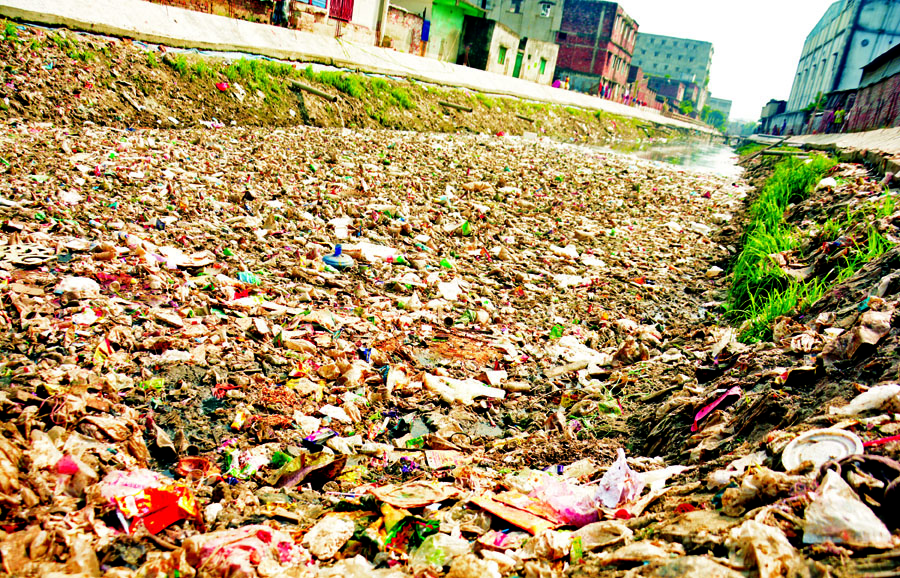
Staff Reporter :
Canals in Dhaka are dying fast due to regular dumping of garbage by local residents.
They (canals) now chocked with thick layer of non-degradable materials like polyethylene and household wastes because of indiscriminate dumping of wastes forcing many to mistake the canals for a landfill.
Visiting at the Hazaribagh canal in Dhaka, it was found that the water body almost vanished and it looked like a landfill as a thick layer of polythene covered on it due to careless dumping of garbage.
The canal now turns a virtual death trap, particularly for the children, who while playing around it, get down on it considering the upper layer to be solid ground.
Like, Hazaribagh canal, other canals in the capital are also disappearing fast.
Dhaka Water Supply and Sewerage Authority (WASA) is responsible to look after the canals that are the only ways to drain rainwaters from Dhaka city. But the organisation did not dredge and clean at least 10 of the 26 canals in the last fiscal, official sources said.
As a result, several parts of the capital city are witnessing perennial waterlogging in this year.
Officials said they did not clean any canals this time. As for land acquisition and excavation/ re-excavation projects in Hazaribagh, Baishteki, Kurmitola, Manda and Begunbari canals, which is scheduled to be completed by December this year, the progress of the project is only 1.5 per cent.
The rainwater of Dhaka city is mainly discharged through 385km-long drains, 10km box culverts and 80km-long 26 canals owned by the WASA.
Bangladesh Institute of Planners general secretary Dr Adil Mohammed Khan said, “We are not able to make the best use of all the canals we have. If all the canals were cleaned, at least it would be known how much they can reduce the level of waterlogging. It is necessary to clean the canals every year to ensure its maximum use, rather than taking up scattered new projects.”
“There has not been any major work to resolve the waterlogging problem in the city. The reality is, there will be inundation due to rainwaters and people will suffer again,” he added.
According to the district administration of Dhaka, the city once had around 58 canals which are now almost dead due to encroachment or dumping of waste. Of the 58 canals, at least 26 can still be revived, said the the Centre for Environment and Geographical Information Services (CEGIS).
The research centre suggested connecting the 26 canals with four rivers surrounding Dhaka city — Buriganga, Balu, Turag, and Sitalakshya rivers — to ease the city’s waterlogging.
The 26 dying or dead canals include Katasur, Hazaribagh, Ibrahimpur, Kalyanpur, Abdullahpur, Ramchandrapur, Baunia, Dwigun, Diyabari, Dholai, Rayerbazar, Baishteki, Shahjahanpur (west), Jirani, Manda, Meradiya-Gojaria, Kosaibari, Shahjahanpur (east), Shahzadpur, Sutibhola, Dumni, Boalia, Rampura, Gobindpur, Segunbagicha and Khilgaon-Basabo canals.
The CEGIS presented a paper in a DAP (Detailed Area Plan) meeting in 2016 to find out the do’s and don’ts for lessening waterlogging of Dhaka city. It also suggested freeing the canals from encroachment. However, no progress has been made was seen taken regarding this.
The research institute also recommended freeing the rivers that surrounded Dhaka city from encroachers. Building any kind of structure on the banks of canal and river were also suggested to be thwarted strictly.

